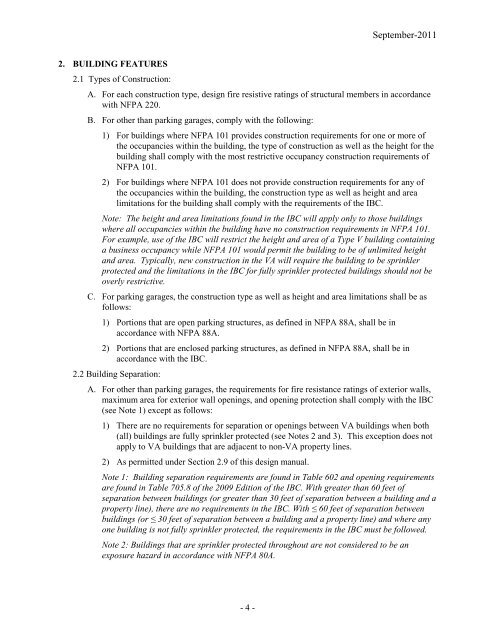Fire Protection Design Manual - Office of Construction and Facilities ...
Fire Protection Design Manual - Office of Construction and Facilities ...
Fire Protection Design Manual - Office of Construction and Facilities ...
Create successful ePaper yourself
Turn your PDF publications into a flip-book with our unique Google optimized e-Paper software.
September-2011<br />
2. BUILDING FEATURES<br />
2.1 Types <strong>of</strong> <strong>Construction</strong>:<br />
A. For each construction type, design fire resistive ratings <strong>of</strong> structural members in accordance<br />
with NFPA 220.<br />
B. For other than parking garages, comply with the following:<br />
1) For buildings where NFPA 101 provides construction requirements for one or more <strong>of</strong><br />
the occupancies within the building, the type <strong>of</strong> construction as well as the height for the<br />
building shall comply with the most restrictive occupancy construction requirements <strong>of</strong><br />
NFPA 101.<br />
2) For buildings where NFPA 101 does not provide construction requirements for any <strong>of</strong><br />
the occupancies within the building, the construction type as well as height <strong>and</strong> area<br />
limitations for the building shall comply with the requirements <strong>of</strong> the IBC.<br />
Note: The height <strong>and</strong> area limitations found in the IBC will apply only to those buildings<br />
where all occupancies within the building have no construction requirements in NFPA 101.<br />
For example, use <strong>of</strong> the IBC will restrict the height <strong>and</strong> area <strong>of</strong> a Type V building containing<br />
a business occupancy while NFPA 101 would permit the building to be <strong>of</strong> unlimited height<br />
<strong>and</strong> area. Typically, new construction in the VA will require the building to be sprinkler<br />
protected <strong>and</strong> the limitations in the IBC for fully sprinkler protected buildings should not be<br />
overly restrictive.<br />
C. For parking garages, the construction type as well as height <strong>and</strong> area limitations shall be as<br />
follows:<br />
1) Portions that are open parking structures, as defined in NFPA 88A, shall be in<br />
accordance with NFPA 88A.<br />
2) Portions that are enclosed parking structures, as defined in NFPA 88A, shall be in<br />
accordance with the IBC.<br />
2.2 Building Separation:<br />
A. For other than parking garages, the requirements for fire resistance ratings <strong>of</strong> exterior walls,<br />
maximum area for exterior wall openings, <strong>and</strong> opening protection shall comply with the IBC<br />
(see Note 1) except as follows:<br />
1) There are no requirements for separation or openings between VA buildings when both<br />
(all) buildings are fully sprinkler protected (see Notes 2 <strong>and</strong> 3). This exception does not<br />
apply to VA buildings that are adjacent to non-VA property lines.<br />
2) As permitted under Section 2.9 <strong>of</strong> this design manual.<br />
Note 1: Building separation requirements are found in Table 602 <strong>and</strong> opening requirements<br />
are found in Table 705.8 <strong>of</strong> the 2009 Edition <strong>of</strong> the IBC. With greater than 60 feet <strong>of</strong><br />
separation between buildings (or greater than 30 feet <strong>of</strong> separation between a building <strong>and</strong> a<br />
property line), there are no requirements in the IBC. With ≤ 60 feet <strong>of</strong> separation between<br />
buildings (or ≤ 30 feet <strong>of</strong> separation between a building <strong>and</strong> a property line) <strong>and</strong> where any<br />
one building is not fully sprinkler protected, the requirements in the IBC must be followed.<br />
Note 2: Buildings that are sprinkler protected throughout are not considered to be an<br />
exposure hazard in accordance with NFPA 80A.<br />
- 4

















